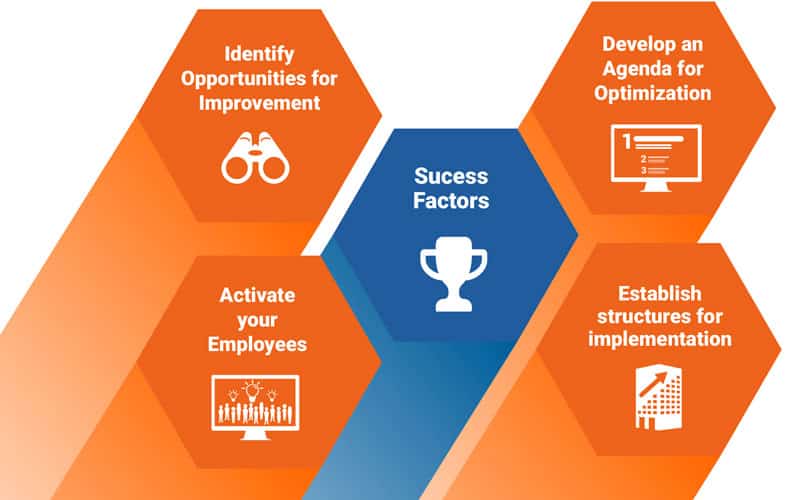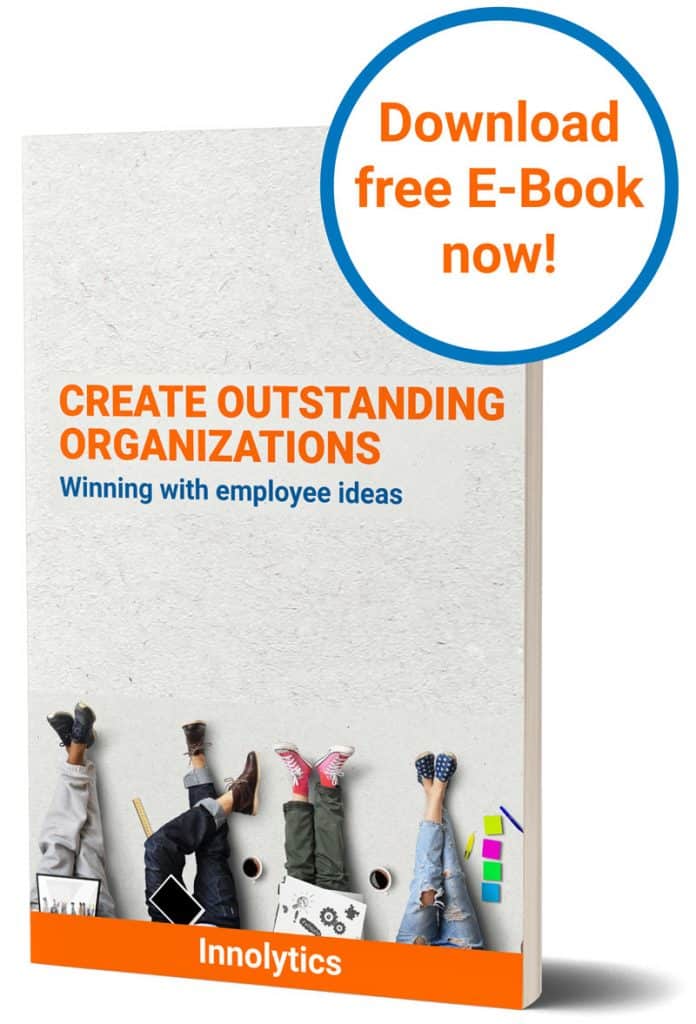Continuous Improvement Process
The Complete Guide to the Continuous Improvement Process

Learn why continuous improvement is essential for companies to succeed. Discover the principles of a highly successful continuous improvement process. Learn how to get started fast and easy with free CIP software!
- Why do Companies Need a Continuous Improvement Process?
- Discover more insights about continuous improvement
- History of the continuous improvement process
- The five most important questions on the continuous improvement process (CIP)
- Characteristics and objectives of the continuous improvement process
- The continuous improvement process
- Continuous improvement management: prerequisites for a successful continuous improvement process
- Take the test: How well is your CIP anchored in your corporate culture?
- Developing solution ideas in the continuous improvement process
- Typical roles in the continuous improvement process
- Barriers in the continuous improvement process
Why do Companies Need a Continuous Improvement Process?
Highly efficient processes and lean structures are the most important competitive factors for organizations. Successful companies regularly put all processes and procedures to the test. They challenge the status quo, proactively search for inefficient activities, and develop unique solutions for more efficient operational processes.
- The continuous improvement process plays an increasingly important role in enterprises.
- Improving business performance is closely related to the concepts of idea management and process improvement.
- In contrast to the concept of innovation and the method of innovation management, where progress is often achieved through technological leaps, the continuous improvement process is a far more gradual method.
Many companies establish a continuous improvement process because they have to prove structures and processes for quality optimization within the scope of an IS0 9001 certification.
But CIP is much more: it is a fundamental attitude within a company to achieve improvements of processes and products, as well as gains in quality and efficiency through continuous brainstorming and systematic idea development.
These improvements are traditionally developed by quality circles, CIP teams, and idea workshops. Due to the possibilities of digitalization, modern tools such as CI-software are increasingly being used.
Innolytics® provides organizations with an easy to start free CIP software! Up to 15 users can access the platform with no costs.
Discover more insights about continuous improvement
History of the continuous improvement process
The idea of involving employees in process improvement has a long history. In the German-speaking world, it can be traced back to 1888. At the time, the tycoon Alfred Krupp wrote in a frequently cited publication that:

“suggestions and suggestions for improvements […] should be gratefully received from all parts of the employees, and promoted by referring the direct superior to the directorate”
Krupp already identified one of the major problems in managing employee’s suggestions: How should supervisors deal with employees who are motivated and provide suggestions, but whose ideas are either not fully developed or cannot yet be implemented? Krupp wrote:

“A rejection of the proposals made should not take place without a prior examination of the proposals. It must also be expected that a successful rejection is sufficient for the person concerned, even if he cannot be given all the reasons for the rejection, and does not give him any reason to be sensitive or complain.”
The Influence of KAIZEN on Continuous Improvement
As a management principle, the method of continuous improvement process (CIP) is strongly inspired by the philosophy of KAIZEN.
- In Japanese culture, KAIZEN (literally “change for the better”) is part of the philosophy of life.
- The change for the better, the quest for perfection through small steps every day.
- In essence, you are already a KAIZEN supporter if you train every day and try to optimise your work processes.
The philosophy of KAIZEN has an impact on private life, too: Through continuous improvement you can perfect your home or your leisure time. It is up to you whether you want this, in any case.
The Innolytics® Software for Continuous Improvement is free for up to 15 users. You can start right away to improve the quality and efficiency of processes!
The five most important questions on the continuous improvement process (CIP)
In our many years of practice, we have been confronted time and again with questions about continuous improvement and the continuous improvement process in the company. We have compiled the five most important questions and answers for you.
What is the difference between CIP and idea management?
CIP (continuous improvement process) is an active method by which teams continuously improve processes, especially in the area of production. Idea management refers to a general procedure by which the ideas of employees from the entire company are collected, evaluated and rewarded. Despite these differences, there are also overlaps between idea management and CIP.
What is a CIP team?
A CIP team is put together within the company and usually consists of a CIP coach and several employees from the department. Weak points in existing processes are analyzed together in CIP circles and CIP workshops and solutions to increase efficiency are developed. The CIP team is an integral part of the continuous improvement process.
Is CIP the same as process optimization?
Process optimization is the generic term for what is to be achieved through the continuous improvement process (CIP). The continuous improvement process is – similar to methods such as Six Sigma or KAIZEN – about measuring the efficiency of processes before and after. CIP is therefore rather the method, while process optimization is the goal.
What does a CIP coach do?
A CIP coach organizes the continuous improvement process and conducts CIP circles in the company. He or she is often a method expert and uses methods for ideation and idea generation to moderate workshops and develop solutions. A CIP coach acts like an internal trainer who guides and motivates colleagues.
What is the difference between process innovation and CIP?
In process innovation processes are newly developed or radically changed. The continuous improvement process is more about taking individual elements of existing processes and optimizing them. Process innovation, for example, is the use of artificial intelligence within processes, while CIP is more about finding weak points and developing solutions within existing processes.
Characteristics and objectives of the continuous improvement process
CIP is – and here are the parallels to KAIZEN – at its core a philosophy and not a doctrine. It is not so much a matter of ensuring that process steps are adhered to. On the contrary: CIP may be, and should be, fun! To ensure that this philosophy is not lost in day-to-day business, however, the continuous improvement process needs structures to support it. For example, specialists are needed to drive the process forward and support employees in analysing problems and developing ideas.

- How can we increase our productivity? How can we get more out of our company and our processes?
- Where is there potential for savings? Where can we save time so that more employees can carry out work with higher quality and priority? Where are bureaucratic hurdles to efficient work?
- How can we improve our product quality or production quality?
Amongst other things, continuous improvement specialists have the task of motivating employees, who have made intelligent and viable suggestions, to provide further ideas. The most important principle is: every suggestion is followed by a quick response with a thank you. Even if an idea is rejected, those responsible for the CIP express their gratitude in the continuous improvement process and explain the reasons for this. This is based on simple logic: anyone who expresses an idea, from which he or she does not profit directly, makes a gift to his or her company. Whoever accepts a gift without saying thank you or ignoring it does not have to expect any further gifts.
The continuous improvement process
In the first step, the continuous improvement process begins with opportunity scouting: a systematic identification of problems in workflows and processes. For this purpose, internal workshops are usually held in the form of quality circles. These are conducted by a continuous improvement manager or coach. In the quality circle, the actual status is questioned with regard to the quality and efficiency of processes and products. At the same time, solutions are sought – for example, examples of companies that have better organized certain processes. The aim of the first phase is to identify opportunities for optimization and improvement.

The second step is idea generation and concept development. For this purpose different creativity techniques are used. The ideas are further developed into concepts through in-depth questions. In the third step, the ideas are evaluated with regard to their suitability for solving the problem and their feasibility. In the fourth step, the best ideas and concepts are implemented.
Continuous improvement management: prerequisites for a successful continuous improvement process
In order for a continuous improvement process to be firmly anchored within a company, a sustainable commitment is required. The following example from a company shows how it does not work: A divisional manager asks his employees to submit suggestions for improving product and process quality by e-mail. Employees are concerned. They send their ideas. A week later they still haven’t received an answer from the divisional manager. Individual solutions and ideas will be worked on in the coming weeks, while others will not. The initiative fails: A flash in the pan instead of continuous improvement. Worse still, initiatives such as these leave behind demotivated employees. Statements such as “impertinence” and “Why should I think about it when there’s no interest anyway?” show that initiatives for ideas and improvement – without a functioning CIP system – can have a demotivating effect. Even in their daily work, employees quickly get the feeling that their ideas and suggestions for solutions are not taken into consideration. Perhaps their CIP ideas just didn’t fit the current agenda of an executive and were therefore ignored. This reaction – understandable from an executive’s point of view – can quickly take the wind out of the sails of employees: To avoid disappointment, they prefer to remain silent. Here, the methods of the continuous improvement process offer solutions. A good CIP system is characterised by the fact that everyone involved benefits: The company receives a large number of suggestions for improvement, the individual employees feel as if they are being taken seriously and are able to develop, which increases their motivation and improves the working atmosphere.

The company
- saves costs by simplifying workflows, reducing unnecessary expenses and making bureaucratic procedures more efficient
- begins a process of continuous self-optimisation and improvement that contributes to achieving economic goals
- involves employees in the continuous improvement process and thus creates an awareness of entrepreneurial thinking
The employees
- have an opportunity to design and improve their own working environment through CIP
- get the feeling of being heard and needed, which has a significant influence on their satisfaction and motivation
- can benefit from the savings in the form of recognition or even rewards
Take the test: How well is your CIP anchored in your corporate culture?
The following 10 questions are intended to help you assess whether your corporate culture promotes or hinders CIP. Assess the situation as realistically as possible. For example, if it says “Even unusual suggestions and ideas are welcome”, you only answer with “Yes” if no one in your company laughs, twists their eyes, moans or something similar in the case of “weird” ideas.
- The further the answers are to the right, the more KVP is included as a philosophy in your corporate culture.
- The more left the answers are, the less cultural support for a continuous improvement process.



